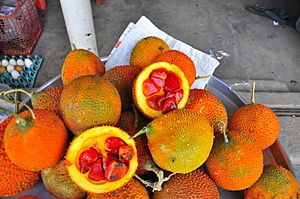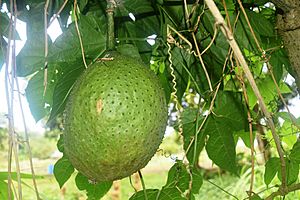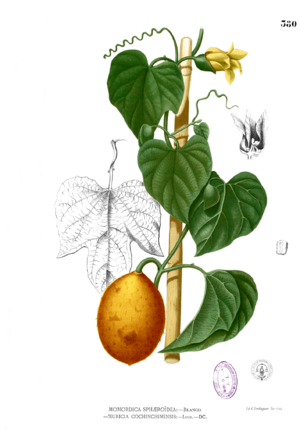Gac facts for kids
Quick facts for kids Gấc |
|
|---|---|
 |
|
| Outside and inside of a Gấc fruit | |
| Scientific classification | |
| Genus: |
Momordica
|
| Species: |
cochinchinensis
|
Gấc (say 'gak') is a special fruit that grows like a vine, similar to a melon. You can find it in countries across Southeast Asia and also in Northeastern Australia. Gấc is famous for its bright orange-red color. This amazing color comes from natural ingredients called beta-carotene and lycopene, which are good for you!
Contents
What's in a Name?
The name Gấc comes from Vietnam, where the fruit first grew. In Vietnam, people often call it gấc. Sometimes, they might also say trái gấc or quả gấc, because trái and quả mean 'fruit' in Vietnamese.
The scientific name for Gấc is Momordica cochinchinensis. The word cochinchinensis comes from the Cochinchina region in southern Vietnam. Even though it's named after this area, Gấc is now grown and enjoyed in many places around the world.
How Gấc Grows
Gấc plants grow as long vines that can reach up to 20 metres (70 ft)! They are special because they have separate male and female flowers on different plants. This means you need both male and female plants for the fruit to grow.
Gấc flowers are usually 5–10 centimetres (2–4 in) long. The plant blooms once a year, about two to three months after the vines are planted. In just one season, a single Gấc plant can produce between 30 and 60 fruits!
The Gấc Fruit

Gấc fruits are usually round or oval-shaped. They are about 13 centimetres (5 in) long and 10 centimetres (4 in) wide. The outside of the fruit is covered with small spines.
When Gấc fruits are growing, they change color. They start green, then turn yellow, then orange, and finally bright red when they are ready to be picked. When picked, the fruit is hard, but it quickly becomes soft. This makes it a bit tricky to store and move around.
Inside, Gấc fruit has a mild taste and thick flesh. It has two main parts: the yellow fruit part and the red seed membrane. Bigger fruits tend to have more of the edible red part around the seeds.
Growing Gấc Plants
Since Gấc plants have separate male and female flowers, farmers need both types of plants to grow fruit. This means they must have at least one male plant near the female plants for pollination to happen. If you grow Gấc from seeds, you can't always tell if you'll get a male or female plant.
Insects can help with pollination, but farmers can also hand-pollinate the flowers to get more fruit. Another way to grow Gấc is by grafting. This is when you attach a part of a female plant onto a male plant.
For the best pollination by insects, it's suggested to have about 1 male plant for every 10 female plants. If farmers grow Gấc from vines, they cut a piece of the vine (about 15–20 centimetres (6–8 in) long) and root it in water or moist soil before planting.
Besides Southeast Asia, where Gấc is native, it can also grow in sub-tropical areas. However, cold temperatures can stop it from growing well.
How People Use Gấc
Gấc has been used for a long time in its native countries, mainly as food and in traditional medicine. People have used it as medicine for over 1200 years in China and Vietnam. The seeds of Gấc, called mù biē zǐ (which means 'wooden turtle seed'), are used in traditional medicine for different purposes, both inside the body and on the skin.
When Gấc fruits are ripe, the red part around the seeds is cooked with sticky rice to make a traditional Vietnamese dish called xôi gấc. This dish is bright red and often served at weddings and New Year celebrations.
In India, the unripe green Gấc fruit is used as a vegetable. The spiny skin is removed, and the fruit is sliced and cooked, sometimes with potatoes or bottle gourd. In Sri Lanka, Gấc is used in curries, and in Thailand, it's even served with ice cream!
Because Gấc is so rich in beta-carotene and lycopene, extracts from the fruit's red parts are used to make dietary supplements. These often come in soft capsules or are sometimes mixed into drinks.
What's Inside Gấc?
Gấc fruit, its seeds, and the oil from its seeds have a lot of beta-carotene and lycopene. These are the natural colors that give the fruit its special red-orange color. Both the red part around the seeds and the seeds themselves are rich in healthy fats, like monounsaturated and polyunsaturated fatty acids. Gấc oil is made up of 69% unsaturated fats, with 35% being polyunsaturated fats. Gấc also has a high amount of linoleic acid (omega-6) and omega-3 fatty acids, which are important for your health.



